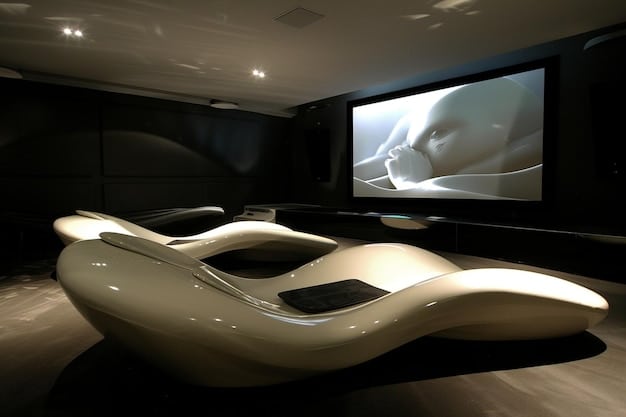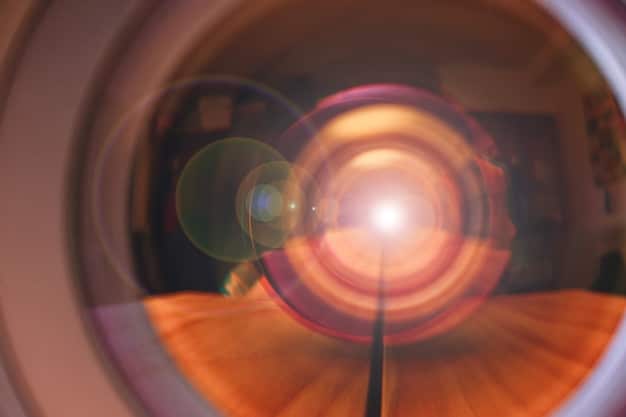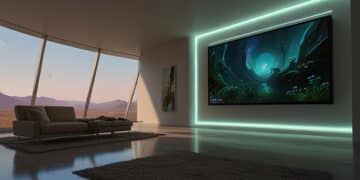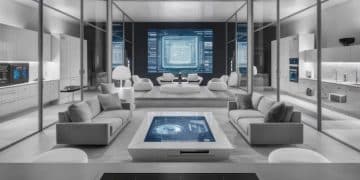Smart Home Entertainment: Optimizing Home Theaters with 8K Projectors

Anúncios
Enhancing your home theater experience with 8K projectors elevates smart home entertainment to an unparalleled level, delivering immersive visuals, superior clarity, and future-proof connectivity for a truly cinematic and integrated viewing environment.
The landscape of home entertainment is undergoing a significant transformation, driven by advancements in display technology and smart home integration. For enthusiasts seeking the ultimate cinematic experience within their own four walls, Smart Home Entertainment: Optimizing Your Home Theater with 8K Projectors represents the pinnacle of this evolution. Imagine crystal-clear images, vibrant colors, and unparalleled detail that bring movies, games, and live events to life on a grand scale, all seamlessly controlled through your smart home ecosystem.
The Evolution of Home Theater: From HD to 8K Immersion
The journey of home theater setups has been a fascinating one, continually pushing the boundaries of visual and auditory fidelity. From the early days of standard definition to the widespread adoption of high-definition (HD) and then 4K Ultra HD, consumers have consistently sought out sharper images and more immersive experiences. The advent of 8K resolution marks a monumental leap forward, quadrupling the pixel count of 4K and creating a visual canvas of breathtaking detail and realism. This shift is not merely about more pixels; it’s about eliminating the perception of individual pixels, allowing the viewer to be fully absorbed in the content without distraction.
As technology progresses, the bar for what constitutes a “premium” home entertainment experience is constantly being raised. What was once considered cutting-edge yesterday is often surpassed by today’s innovations. This relentless pace of development presents both exciting opportunities and challenges for consumers looking to invest in their home theater systems. Understanding the foundational shift from lower resolutions to 8K is crucial for appreciating the transformative power of these new projectors and how they redefines smart home entertainment spaces.
Pioneering Visual Fidelity: What 8K Really Means
8K resolution, specifically 7680×4320 pixels, offers an astonishing level of detail that needs to be seen to be truly appreciated. This density of pixels creates an image so smooth and lifelike that it blurs the line between reality and the projected image. It’s particularly impactful on large screens, where the individual pixels of lower resolutions might become discernible, detracting from the immersion.
- Unmatched Detail: Four times the resolution of 4K, delivering incredible sharpness.
- Enhanced Immersion: Pixels become virtually invisible, drawing you deeper into the content.
- Future-Proofing: Ready for upcoming 8K content and larger screen formats.
The impact of 8K extends beyond sheer pixel count. It influences color reproduction, contrast ratios, and the overall dynamic range, as the increased data allows for more nuanced representation of light and shadow. This holistic improvement reshapes how we perceive digital content, making it feel more tangible and immediate. The sheer scale and clarity provided by 8K projectors are central to creating a truly captivating cinematic atmosphere right in your living room or dedicated media space.
The Leap to 8K Projectors
While 8K TVs have gained traction, 8K projectors offer a distinct advantage: scalability. The ability to project an enormous image—often exceeding 100 or even 200 inches—without significant loss of clarity is revolutionary. This makes 8K projection ideal for dedicated home theaters where an expansive, cinema-like experience is paramount. Early adopters are already experiencing how these projectors transform their viewing spaces, turning ordinary rooms into extraordinary entertainment hubs. The larger the screen, the more pronounced the benefits of 8K resolution become, showcasing every intricate detail in stunning fashion.
In conclusion, the move to 8K is not just an incremental upgrade; it is a paradigm shift in how we experience visual content at home. For those serious about their home theater setup, embracing 8K projection is a step towards achieving a level of immersion and detail that was once relegated to commercial cinemas. The integration of 8K into smart home entertainment systems allows for a seamless, high-end experience that previous generations of technology simply couldn’t deliver, setting a new standard for home viewing excellence.
Integrating 8K Projectors into Your Smart Home Ecosystem
The true power of modern home entertainment lies not just in cutting-edge display technology, but in its seamless integration with a smart home ecosystem. An 8K projector, while impressive on its own, reaches its full potential when it becomes an intelligent component of a connected living space. This section explores how to effectively mesh your high-resolution projector with smart home devices, allowing for intuitive control, automated scenarios, and a truly unified entertainment experience.
Smart home integration transforms a collection of devices into a cohesive, responsive environment. When your 8K projector communicates effortlessly with your lighting, audio system, and even climate control, the initiation of movie night becomes a single command away. This level of automation enhances convenience, optimizes viewing conditions, and adds a layer of sophistication to your home theater setup that manual controls simply cannot match. It’s about creating an experience, not just consuming content.
Connectivity and Control Protocols
Successful integration heavily relies on compatible connectivity and control protocols. Most modern 8K projectors support standard smart home communication methods like Wi-Fi and Ethernet. Beyond that, understanding specific protocols like HDMI-CEC (Consumer Electronics Control), IP control, and integration with popular smart home hubs (e.g., Savant, Control4, Crestron, or even consumer-level platforms like Google Home and Amazon Alexa) is crucial. These protocols enable devices to “talk” to each other, forming a network where commands can be executed across multiple systems simultaneously.
- Wi-Fi & Ethernet: Standard for network connectivity and updates.
- HDMI-CEC: Allows devices connected via HDMI to control each other (e.g., turning on the projector turns on the receiver).
- IP Control: Enables comprehensive control via network commands, often used by professional integrators.
- Smart Home Hub Integration: Centralizes control through a single app or voice assistant.
Establishing robust network connectivity is the first step. A stable and fast Wi-Fi connection or, ideally, a wired Ethernet connection ensures smooth streaming of large 8K content files and reliable communication with other smart devices. Low latency is key for an uninterrupted and responsive smart home experience when dealing with high-bandwidth content.
Automating the Ultimate Viewing Experience
One of the most compelling aspects of integrating an 8K projector into a smart home is the ability to automate entire viewing scenarios. Imagine saying “Alexa, movie night,” and in response, your projector powers on, the screen descends, the lights dim to the perfect level, the surround sound system activates, and the thermostat adjusts for optimal comfort. This is the power of smart home automation.
This goes beyond simple on/off commands. You can program complex scenes that cater to different types of content: a bright, energetic setting for sports, a warm, ambient setup for relaxed viewing, or a specific configuration for gaming. The integration allows for personalized experiences that are triggered by voice commands, schedule, or even motion sensors, ensuring your home theater is always optimized for the moment. Automating your entertainment setup simplifies usage and ensures consistency, removing any friction between wanting to watch content and actually enjoying it.
User Interface and Control
The user interface for controlling your integrated 8K home theater should be intuitive and accessible. This often comes in the form of a dedicated smart home app, voice assistants, or universal remote controls specifically designed for complex setups. The goal is to provide a single point of control for all components, avoiding the need to juggle multiple remotes or apps. Some advanced systems even offer customizable touch panels built into walls.
Voice control remains a popular and convenient method. Integrating your projector with Amazon Alexa or Google Assistant means you can manage essential functions like power, input selection, and even content navigation with simple vocal commands. This hands-free operation enhances the feeling of luxury and convenience, making the home theater truly effortless to enjoy. The ability to manage everything from a central hub transforms the viewing experience from a technical setup into a seamless interaction.
In summary, integrating an 8K projector into a smart home ecosystem elevates the entire entertainment experience. It moves beyond individual high-tech components to create a unified, intelligent environment where your home responds to your entertainment needs with precision and fluidity. This level of control and automation is essential for truly optimizing a home theater in the era of smart living.
Choosing the Right 8K Projector for Your Home Theater
Selecting an 8K projector is a significant investment that requires careful consideration. With various models on the market, each boasting different features and specifications, understanding what truly matters for your specific home theater environment is key. This section guides you through the essential factors to evaluate when choosing an 8K projector, ensuring it aligns perfectly with your space, budget, and viewing preferences. The right projector forms the cornerstone of an immersive 8K experience, so informed decision-making is paramount to maximizing your entertainment potential.
Your home theater is a unique space, whether it’s a dedicated dark room or a multi-purpose living area. The ambient light, screen size aspirations, and even the seating arrangement will influence which projector features are most critical. Taking these environmental factors into account from the outset will help narrow down the options and prevent common pitfalls that lead to suboptimal viewing experiences. A well-chosen projector integrates seamlessly into your space, enhancing, rather than hindering, its overall aesthetic and functionality.

Key Specifications and Features to Consider
When comparing 8K projectors, several technical specifications stand out as crucial differentiators. Lumens (brightness), contrast ratio, throw distance, and lens shift capabilities are among the primary factors that dictate a projector’s performance in a given setting. Understanding these terms will empower you to make an informed choice that matches your expectations for visual quality and installation flexibility.
- Brightness (Lumens): Higher lumens are better for rooms with ambient light; dedicated dark rooms can use lower lumens.
- Contrast Ratio: Crucial for deep blacks and vibrant whites, enhancing image depth.
- Throw Distance: Determines how far the projector needs to be from the screen for a given image size.
- Lens Shift: Allows for vertical and horizontal adjustment of the image without moving the projector, simplifying installation.
- HDR Support: Essential for taking advantage of High Dynamic Range content, delivering richer colors and better contrast.
Beyond these core specifications, consider features like lamp life (for lamp-based projectors) or laser lifespan (for laser projectors), as well as fan noise, which can be a significant distraction in a quiet viewing environment. Connectivity options, including multiple HDMI 2.1 ports for 8K sources, are also vital for future-proofing your setup.
Optimizing for Different Room Environments
The ideal 8K projector largely depends on the characteristics of your home theater room. A dedicated, light-controlled home cinema room will have different requirements than a multi-purpose living room where ambient light is a constant factor. For dedicated dark rooms, focusing on high contrast ratios and color accuracy becomes paramount, as brightness can be managed.
Conversely, for living rooms or spaces with unavoidable ambient light, a projector with higher lumen output is essential to overcome washout. Features like dynamic iris or ambient light rejection screens can also play a crucial role in these environments. Consider the size of your room and the maximum screen size you desire, as this will directly influence the required throw distance and resolution scaling. A projector’s ability to project a large, perfectly aligned image should match your spatial constraints.
Budgeting for Your 8K Projector
8K projectors represent a premium segment of the home entertainment market, and as such, they come with a significant price tag. Your budget will naturally influence the range of models and features you can consider. While it’s tempting to opt for the most feature-rich model, evaluate whether every advanced capability is truly necessary for your use case. Sometimes, a slightly less expensive model might offer 90% of the performance for a fraction of the cost.
Remember that the projector itself is just one component of the home theater budget. You’ll also need to account for a suitable screen, audio system, cabling, and potentially professional installation. Prioritize features that directly impact your viewing experience and consider long-term costs like lamp replacement or energy consumption. Strategic budgeting ensures you achieve the best possible 8K experience without overspending on unnecessary extras. A comprehensive financial plan helps avoid surprises down the line, ensuring your investment truly enhances your entertainment.
In conclusion, choosing the right 8K projector involves a careful balance of understanding technical specifications, assessing your room environment, and setting a realistic budget. By prioritizing these factors, you can select a projector that not only delivers an unparalleled visual experience but also integrates seamlessly into your smart home, providing years of immersive entertainment.
Setting Up Your 8K Projector for Peak Performance
Once you’ve chosen your 8K projector, the next critical step is proper setup and calibration. Even the most advanced projector won’t deliver its full potential without careful attention to placement, screen pairing, and image optimization. This section provides an essential guide to configuring your 8K projector, ensuring you achieve the sharpest images, most accurate colors, and truly immersive viewing experience that 8K resolution promises. Proper setup is the bridge between owning cutting-edge hardware and experiencing its benefits firsthand.
The environment in which your projector operates plays a vital role in its performance. Small details, often overlooked, can have a significant impact on image quality. From managing ambient light to selecting the correct screen material, each element contributes to the overall visual integrity. Approaching the setup process systematically will yield the best results, transforming your projector from a piece of equipment into the centerpiece of a stunning cinematic display.
Optimal Projector Placement and Screen Pairing
The physical placement of your 8K projector relative to the screen is fundamental. This involves calculating the correct throw distance—the distance between the projector lens and the screen—to achieve your desired image size. Most projectors come with a throw ratio specification that helps in this calculation. Whether ceiling-mounted, shelf-mounted, or placed on a table, ensures the projector is stable and free from vibrations.
Equally important is pairing the projector with the right screen. With 8K resolution, slight imperfections in the screen surface can become noticeable. Considerations include screen gain (how reflective it is), aspect ratio (typically 16:9 for movies), and ambient light rejection properties for rooms with some light leakage. A high-quality, perfectly flat screen surface is crucial for showcasing the minute details of an 8K image. Matte white screens are often preferred for their uniform light distribution and color neutrality in dedicated dark rooms.
Calibration for Picture Perfection
Out-of-the-box settings often don’t fully leverage a projector’s capabilities. Calibration involves adjusting various picture settings to ensure accurate color reproduction, optimal brightness and contrast, and precise sharpness. While professional calibration services offer the best results, even basic user-level adjustments can significantly improve image quality.
- Brightness and Contrast: Adjust to ensure deep blacks and highlight details without crushing or blowing out information.
- Color Temperature: Aim for a natural white balance, typically 6500K (D65) for film content.
- Gamma: Controls the luminescence levels between pure black and pure white, impacting image depth.
- Sharpness: Adjust carefully to enhance detail without introducing artificial edge enhancement.
Using calibration discs or online test patterns can guide you through these adjustments. Pay attention to each setting incrementally, observing the impact it has on the test patterns. The goal is to achieve a balanced, natural-looking image that is true to the source material. This meticulous process ensures that the high resolution of your 8K projector translates into a visually stunning and accurate display.
Cabling and Source Connectivity
For an 8K projector to perform optimally, it requires the right cabling. HDMI 2.1 cables are essential to carry the high bandwidth required for 8K resolution at higher refresh rates (e.g., 8K@60Hz or 4K@120Hz). Standard HDMI cables simply won’t suffice. Ensure your source devices (Blu-ray players, streaming boxes, gaming consoles) also support HDMI 2.1 for end-to-end 8K signal integrity.
Proper cable management is also important, not only for aesthetics but also to prevent signal interference and wear and tear on ports. Use high-quality, certified HDMI 2.1 cables, especially for longer runs. Overlooking cabling can lead to frustrating issues such as flickering, dropped signals, or inability to display 8K content, undermining your investment in an 8K projector. Establishing a reliable digital pathway from source to screen is non-negotiable for true 8K performance.
In conclusion, a meticulous approach to setting up your 8K projector is vital for unlocking its full potential. From strategic placement and screen selection to precise calibration and appropriate cabling, each step contributes to transforming your home theater into a truly cutting-edge entertainment hub. Attention to these details ensures that your 8K projector delivers the breathtaking, immersive visuals it was designed for.
Enhancing the 8K Experience: Audio, Lighting, and Beyond
While an 8K projector forms the visual centerpiece of your home theater, a truly immersive smart home entertainment experience extends far beyond the picture. The synergy between pristine visuals, captivating audio, and an intelligently controlled environment is what elevates a good setup to an extraordinary one. This section delves into how to complement your 8K projector with a robust audio system, dynamic smart lighting, and other critical elements that collectively enrich the overall sensory experience, ensuring every detail pulls you deeper into the content.
The human brain processes visual and auditory stimuli simultaneously, meaning deficiencies in one area can detract from the impact of the other. A stunning 8K image paired with substandard audio or an improperly lit room will always feel incomplete. Holistic optimization, therefore, involves treating the home theater as an integrated system where each component works in harmony to maximize immersion and enjoyment. It’s about crafting an atmosphere where every element contributes to the magic of the moment.
The Imperative of Immersive Audio
A high-resolution visual experience demands an equally compelling audio counterpart. Investing in a powerful and precisely configured sound system is non-negotiable for creating a truly cinematic atmosphere. This could range from a dedicated 7.1.4 Dolby Atmos or DTS:X setup with overhead speakers for three-dimensional sound to a high-quality soundbar with wireless surrounds for more compact spaces.
Consideration for audio extends to room acoustics. Implementing sound-absorbing panels, bass traps, and diffusers can significantly improve sound clarity and imaging, reducing echoes and unwanted reverberation. Proper speaker placement is also crucial for achieving accurate spatial audio. Your 8K projector might deliver breathtaking visuals, but it’s the enveloping sound that truly transports you into the world on screen. The ultimate goal is to feel the sound as much as you hear it.
Smart Lighting for Ambiance and Immersion
Traditional room lighting can severely diminish the impact of projected images. Smart lighting solutions, however, can be integrated into your home theater setup to enhance ambiance and even synchronize with on-screen content. Dimmable smart bulbs and LED strips can be programmed to gradually dim when the projector turns on, creating a seamless transition from a brightly lit room to a perfect viewing environment.
Beyond simple dimming, advanced smart lighting systems can offer dynamic effects. For example, bias lighting placed behind the screen reduces eye strain and enhances perceived contrast. Some systems can even mimic the colors on the screen, extending the visual experience beyond the boundaries of the display. This intelligent control over illumination transforms the room itself into part of the entertainment, tailoring the environment to the content.
Comfort, Seating, and Climate Control
The physical comfort of your home theater is just as important as its technical prowess. Ergonomic seating designed for long viewing sessions ensures fatigue doesn’t detract from the experience. Reclining seats, acoustic treatments, and personal climate control options contribute significantly to the overall enjoyment. Integrating smart thermostats allows you to preset the room temperature for movie nights, ensuring optimal comfort before you even sit down.
Consider also the overall aesthetics and functionality of the space. Cable management, soundproofing, and even the strategic placement of snacks and beverages through smart mini-fridges can all enhance the user experience. A well-designed home theater is not just about the gear; it’s about creating a dedicated sanctuary for entertainment. This holistic approach ensures that every aspect of the environment contributes to a seamless and enjoyable experience, making your home theater a true escape.
In conclusion, while an 8K projector provides the core visual splendor, optimizing your smart home entertainment beyond the screen is paramount for a truly immersive experience. By investing in high-fidelity audio, intelligent lighting, and thoughtful environmental controls, you create a cohesive and captivating home theater that transcends mere viewing and becomes a deeply engaging sensory journey.
The Future of Home Entertainment: Beyond 8K Projectors
As we revel in the immediate grandeur of 8K projection, it’s natural to peer into the horizon and anticipate what lies next for home entertainment. The technological landscape is in constant flux, with new innovations continually pushing the boundaries of immersion, interactivity, and convenience. This section explores emerging trends and speculative advancements that could shape the future of smart home entertainment, suggesting that while 8K projectors are a pinnacle today, the journey towards ultimate digital immersion is far from over.
The evolution of home entertainment isn’t a series of isolated leaps but rather a continuous convergence of disparate technologies. Artificial intelligence, virtual and augmented reality, and ever-faster connectivity are poised to redefine how we consume media and interact with our living spaces. Understanding these potential shifts allows us to appreciate the present state of 8K and prepare for the exhilarating possibilities that tomorrow may hold. The path forward is one of increasing realism and seamless integration.
Holographic Displays and Volumetric Video
Beyond flat screens, even those as sharp as 8K, the ultimate dream of visual technology is holographic projection or volumetric video. Imagine content that appears to float in your living room, viewable from any angle, without the need for glasses or a screen. While still a nascent technology, breakthroughs in light field displays and direct pixel projection are hinting at a future where 3D content is truly dimensional and interactive.
This could transform home entertainment from a passive viewing experience to an active, shared reality. Sports events could feel like you’re on the field, concerts as if the band is performing live in your space, and video calls could resemble face-to-face conversations. Though mass adoption is years away, researchers are continually making strides in creating believable, free-floating imagery that could eventually supersede traditional projection.
The Rise of AI in Content and Control
Artificial Intelligence is already ingrained in smart home ecosystems, but its role in entertainment is set to expand dramatically. AI could personalize content recommendations with unprecedented accuracy, analyze viewer preferences to dynamically adjust picture and sound settings in real-time, or even generate interactive narratives that adapt to your choices.
Beyond passive consumption, AI will enhance voice control, enabling more natural and complex commands. Imagine an AI assistant that not only plays a movie but also dynamically adjusts ambient lighting based on scene changes, orders snacks based on your viewing history, or even subtly modifies dialogue volume for clearer understanding. AI will become the unseen conductor of your entire smart home entertainment orchestra, ensuring a seamless and personalized experience. The future promises a level of intuitive interaction previously only dreamt of in science fiction.
Enhanced Interactivity and Multi-Sensory Experiences
The future of home entertainment may move beyond just sight and sound. Haptic feedback systems integrated into seating could simulate impacts or vibrations from the screen, adding a tactile dimension. Olfactory emitters could release scents that match the on-screen environment, creating a truly multi-sensory experience. While these technologies are currently niche, their potential for enhancing immersion is undeniable.
Furthermore, augmented reality (AR) could blend digital content with your physical environment. Instead of a dedicated screen, AR glasses or projectors could overlay virtual elements onto your walls, turning your living room into an interactive game world or a virtual museum. This blurs the line between the digital and physical, opening up new possibilities for how we consume and engage with entertainment, making the entire living space an active part of the experience.
In conclusion, while 8K projectors currently define the pinnacle of home visual entertainment, the horizon promises even more revolutionary advancements. From truly holographic displays to omnipresent AI control and multi-sensory interactivity, the future of smart home entertainment is poised to deliver experiences that are more immersive, personalized, and seamlessly integrated into our daily lives than ever before. This continuous evolution guarantees a thrilling journey for enthusiasts of cutting-edge technology.
Maintenance and Longevity of Your 8K Projector System
An 8K projector system represents a significant investment in your home entertainment, and like any high-tech equipment, proper maintenance is crucial for ensuring its longevity and consistent peak performance. Neglecting routine care can lead to diminished picture quality, reduced lifespan, and costly repairs. This section outlines essential maintenance practices and considerations for keeping your 8K projector and its associated components in optimal condition, ensuring your immersive home theater experience endures for years to come.
Taking proactive steps in maintenance not only extends the life of your equipment but also protects your financial commitment. A well-maintained system operates more efficiently, produces better results, and minimizes unexpected issues that could disrupt your entertainment. Small, regular efforts can prevent larger, more complex problems, allowing you to enjoy your cutting-edge home theater without frequent technical interruptions.
Routine Cleaning and Airflow Management
Dust is the enemy of electronic components, especially in projectors where sensitive optics and cooling systems are involved. Regular, gentle cleaning of the projector lens with a microfiber cloth and lens cleaning solution is essential to prevent smudging and maintain image clarity. Ensure the projector’s air intake and exhaust vents are clear of obstructions and dust build-up.
Proper airflow is vital for cooling the lamp or laser. Overheating can significantly shorten the lifespan of internal components and lead to performance degradation. If your projector is in an enclosed space, ensure adequate ventilation and consider auxiliary cooling fans if necessary. Regularly vacuuming around the projector can help reduce airborne dust particles from entering the unit and accumulating on internal components. Keeping the environment clean minimizes wear and tear.
Lamp Replacement Cycles and Laser Lifespan
Depending on your 8K projector model, it will either use a traditional lamp or a laser light source. Lamp-based projectors have a finite lamp life, typically ranging from 2,000 to 5,000 hours in normal mode, which decreases in brighter modes. Being aware of your projector’s lamp hours and planning for timely replacement is crucial for maintaining brightness and color accuracy.
Laser projectors, on the other hand, boast significantly longer lifespans, often exceeding 20,000 hours, making them virtually maintenance-free in terms of light source replacement. However, even laser projectors require attention to cooling and dust prevention. Understanding the light source technology in your projector will guide your maintenance schedule and inform long-term cost considerations. Laser sources offer greater peace of mind due to their extended operational life.
Firmware Updates and System Checks
Manufacturers frequently release firmware updates for projectors, addressing bugs, improving performance, and sometimes adding new features. Regularly checking for and installing these updates can ensure your projector operates with the latest enhancements and remains compatible with evolving content standards. Most smart 8K projectors can connect to the internet to perform these updates directly.
Beyond firmware, periodically check all cable connections to ensure they are secure and free from damage. Test different input sources to confirm seamless switching. Listen for any unusual noises coming from the projector, which could indicate a fan issue. A quick system check every few months can proactively identify and address minor issues before they escalate into major problems, maintaining the reliability of your entire home theater setup. Keeping connections pristine is vital for uninterrupted high-quality content delivery.
In conclusion, maintaining your 8K projector system is an ongoing commitment that pays dividends in longevity and consistent performance. By adhering to routine cleaning schedules, understanding your light source’s lifespan, and performing regular system checks and firmware updates, you can safeguard your investment and continue to enjoy an unparalleled smart home entertainment experience for many years to come.
| Key Point | Brief Description |
|---|---|
| 🎬 8K Resolution Benefits | Offers unparalleled detail and immersion, making pixels virtually invisible on large screens for a true cinematic feel. |
| 🏡 Smart Home Integration | Seamlessly connects with smart devices for automated control of lighting, audio, and climate, enhancing convenience. |
| 🛠️ Optimal Setup & Calibration | Crucial for maximizing visual quality, involving correct placement, screen pairing, and image fine-tuning with HDMI 2.1 cables. |
| 🔊 Holistic Enhancement | Beyond visuals, immersive audio, smart lighting, and comfortable seating complete the ultimate home theater experience. |
Frequently Asked Questions About 8K Projectors
8K resolution is 7680×4320 pixels, meaning it has four times the pixels of 4K (3840×2160 pixels). This higher pixel density results in a significantly sharper and more detailed image, especially noticeable on large screens, where individual pixels become virtually invisible, creating a more immersive viewing experience.
Yes, to fully utilize an 8K projector, you need certified HDMI 2.1 cables. These cables support the increased bandwidth required for 8K resolution at higher refresh rates (e.g., 60Hz), ensuring a stable and high-quality video signal from your source devices to the projector without any signal degradation or loss.
Yes, 8K projectors typically feature advanced upscaling technology. This means they can intelligently upscale lower-resolution content (like 4K or HD) to near-8K quality by adding interpolated pixels and enhancing details. While not true native 8K, upscaling significantly improves the visual experience, making older content look better than ever.
Smart home integration allows for automated control of your entire home theater environment. You can program scenes where a single voice command dims lights, lowers the screen, powers on the projector and audio system, and adjusts climate, creating a seamless and optimized viewing experience with ultimate convenience and personalization.
8K projectors primarily use either traditional lamps or laser light sources. Lamp-based projectors are often more affordable initially but require lamp replacements. Laser projectors offer significantly longer lifespans (over 20,000 hours), higher brightness, and faster startup times, providing a virtually maintenance-free light source for extended periods.
Conclusion
The pursuit of the perfect home theater experience has led us to the transformative power of 8K projectors, a pivotal technology in the realm of smart home entertainment. By offering unparalleled visual clarity and immersion, these devices redefine what’s possible within our personal viewing spaces. Beyond the sheer pixel count, optimizing this cutting-edge display with smart home integration, meticulous setup, and complementary audio and environmental controls truly unlocks its full potential. The blend of stunning visuals and intelligent automation creates a home theater that is not just a room with a big screen, but a dynamic, responsive entertainment sanctuary capable of delivering cinematic experiences right at our fingertips.





